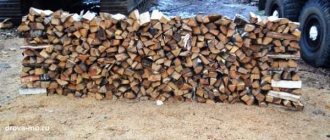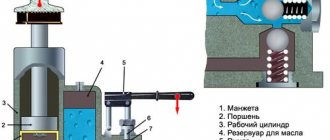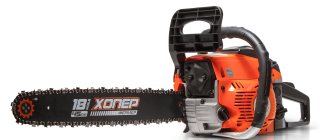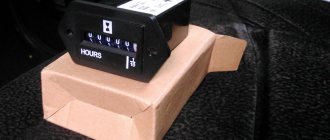Modern technologies make it possible to produce heating using various types of fuel. However, wood is still considered the most in demand today. Let's consider how you can determine how much a cube of firewood is. Let's get acquainted with the concepts of actual volume of wood, folded and bulk. Read to the end and you will learn from examples how many different logs will be delivered by the same transport.
Cart of chopped wood Source fermer.ru
How to calculate how many cubic meters of firewood are in a truck? What is the volume of the body?
How is the cubic capacity of firewood in the body, bulk and stacked, calculated?
How many cubic meters of firewood are in ZIL?
How many cubic meters of firewood is in GAZ?
How many cubic meters of firewood are in a GAZelle?
What is the volume of firewood in the bodies of different cars?
What kind of firewood is there more in the car - chopped or unchopped?
It is quite difficult to find out how many cubes of firewood are in a car body, since firstly, firewood can be loaded into the body in different ways, in bulk or neatly folded (from experience - 1 body of logs is 3 bodies of chopped firewood).
Secondly, firewood comes in different sizes, and accordingly the cubic capacity will be different.
Of course, it is best to count not by cubes, but by weight, but even so they can deceive you by first soaking the wood; you won’t take a moisture test for an accurate measurement.
The “Archimedes bath” is best suited here; no matter how much water is displaced from it, so many cubes of firewood will be there, but this is a lyric, but in reality you should proceed using the following method:
Since many people now make car bodies to order or with their own hands, it is best to measure and determine the real cubic capacity of the body.
Firewood should be evenly distributed along the entire perimeter of the body.
So, based on this, you can calculate the cubic capacity of chopped wood in the car.
But as I said above, they can be loaded in different ways!
If the firewood lies neatly, as in the photo on the right, then you can apply a coefficient of 0.7 i.e. the resulting volume of the real volume must be multiplied by 0.7.
What is 0.7 - this is the coefficient that, on average, is used to obtain the volume of solid wood if the wood is folded in even rows (warehouse cubic meter).
For a more accurate calculation, you can use the table of coefficients from GOST 3243-88
If we talk about the approximate volumes of car bodies, then these are the following data:
GAZ-53 - 6 cubic meters. meters (well laid);
ZIL-130 - 2.0 cubic meters. meters (low side, loading along the edge of the side);
ZIL-130 - 2.5 cubic meters. meters (low side, loading with a slide);
Zil with high sides - 8.0 cubic meters. meters;
The gazelle will hold 2.0-3.0 cubic meters, depending on how you stack the firewood.
As we know, we pay our hard-earned money for cubic meters of firewood, which actually provides calories to the body, and this is a full-wood cubic meter of wood without voids.
The yield of clean wood from a firewood machine is influenced by two main factors - whether the firewood was brought to you in lumps or chopped, and whether this firewood was stacked in woodpiles or lay in a heap (outside)
The “closest” to density is considered to be if the unchopped firewood in the machine is stacked in woodpiles (the coefficient of full wood can be up to 0.85), the “farthest” from density is considered to be chopped firewood loaded in bulk - not stacked (the coefficient of full wood can be 0. 55)
For a clear idea, imagine a cubic stacker of a woodpile of uncut wood, which contains 0.85 cubic meters of pure wood, and a cubic stacker of a pile of firewood, which contains 0.55 cubic meters of pure wood. Agree, this is a significant difference!
And here, too, you must definitely check with the seller what you are paying for - for 1 storage meter or for one “clean” cubic meter of wood? Because disagreements often arise on the basis of differences in measurements - the seller estimated it in warehouse meters, and the buyer, having calculated and applied the full-wood coefficient, came to the conclusion that he was deceived.
Differences between the 53A line and the 53
The car models have the following differences:
- reinforced front axle;
- new cardan design;
- more reliable steering gear design;
- new radiator grille;
- turn signals are duplicated by repeaters on the wings of the cabin;
- the presence of electric windshield wipers;
- cabin heating.
In 1973, model 53A was awarded the USSR State Quality Mark. Expanding the functionality of the vehicle, the production of chassis 53 01 for covered bodies and special equipment was launched.
Chassis 53 02 was a platform for the use of a dump truck body and was equipped with a power removal device for a hydraulic pump.
Trucks of models 53 50 and 53 70 were exported. The vehicles were readily purchased in Belgium, Finland, and in socialist countries. In Bulgaria and Cuba, trucks were assembled from kits supplied from GAZ.
Model 53 12 was produced from 1983 to 1992, as a further development of the 53rd line. The truck was equipped with an eight-cylinder ZMZ-511 engine.
Power parameter is 120 hp. With. made it possible to increase the load to 4.5 tons, and the speed indicator to 90 km/h.
Gasoline consumption increased to 30 liters, but provision was made for installing equipment for refueling with liquefied or compressed gas.
Technical characteristics of the basic on-board vehicle GAZ-53:
Source of the article: https://arendavlg.com/gaz/ob-em-kuzova-gaz-53-samosval-v-kubah-ves-gazona-53.html
How much is a cubic meter of firewood?
If you decide to buy firewood, then when placing an order and receiving firewood you may encounter the following question: How to determine the volume of firewood? Indeed, the most common question when buying firewood is the question of volume measurement.
How many cubic meters of wood are in the car? How to calculate the volume of chopped firewood? How to check the seller? Let's figure it out.
The cubic meter is a common unit of measurement for forestry. For round timber (round timber) the concept of a dense cubic meter (solid wood without gaps) is used, and for firewood - a folded cubic meter (counting gaps).
Modifications
The GAZ-53 car was a mass-produced car of the Union republics. There were 4 million machines in operation throughout the country in their usual, as well as dump and specialized versions.
In the period 1961-1967, the GAZ-53F car was produced. It was equipped with a six-cylinder engine with a power of 82 hp. from the GAZ-11, with a four-speed gearbox, it ensured the transportation of 3500 kilograms of cargo, fuel consumption of 24 liters per 100 kilometers of low-octane gasoline. At the time of the model's production, there was no V-twin power unit in production.
For the 53F model, the six-cylinder GAZ-11 engine was boosted, and the compression of the mixture increased. A hypoid rear axle was also not invented, so a mechanism from the 51A model with bevel gears was installed.
In fact, the gas 53 dump truck with a body volume of 4.8 cubic meters of the F model, according to its technical characteristics, was a transitional (intermediate) model between such series as 51A (with a load capacity of 2500 kilograms) and SAZ-53B (the load capacity was increased by a ton), this was achieved by increasing to 3 .7 meters of base and installation of new tires 8.25-20, which are mounted on steel wheels.
The car was used not only as a dump truck; sewage disposal trucks, milk tankers and fuel tankers were also common.
The GAZ-53 car was not a complete design; due to constant breakdowns of mechanical parts, it did not become popular either among drivers or among workers of various repair services and motor transport enterprises. This truck was equipped with a noticeably weak engine, had an unreliable axle, and was produced until 1967.
In the period 1964 -1983, models from the 53 and even 53A series appeared on the roads, with a load load of 3500 and even 4000 kilograms. They were equipped with a more powerful ZMZ-53 engine with a power of 115 hp, which ensured an increase in speed to 85 km/h with a fuel consumption of 25 liters for every 100 kilometers. The body volume of the gas 53 dump truck has not changed.
Firewood cube
Determining the volume of lumber is quite simple if it is neatly folded: multiply the length by the width and by the height and you’re done. It is more difficult to calculate the volume of chopped firewood or firewood in logs. For this, a unit of measure is used - a “folded” cubic meter, i.e. cubic meter of firewood at intervals.
To convert from stored cubic meters to cubic meters of wood, a conversion factor is used, which depends on the type of wood and the size of the logs. In most cases, a coefficient of 0.7 is used for recalculation.
For example: If they bring you firewood stacked, then we measure the length, height and width of this stack. We multiply the parameters and multiply the resulting volume by a factor of 0.7.
Volume = width * length * height * 0.7 - thus, we get the real volume of firewood.
Saransk dump truck plant
The Saransk plant has been operating since 1960, since August. By the end of the first year of its existence, the company had assembled about 10 thousand dump trucks. The plant constantly exceeded the plan and was in good standing, and by 1965 it had already produced its 100,000th dump truck. In the first years, the GAZ-SAZ 53B model rolled off the assembly line; in parallel, the SAZ 3502 model was produced with one-sided unloading of the body and its preliminary lifting. By November 1978, the company had already assembled half a million cars.
Return to contents
Bulk cube of firewood
However, not all sellers stack firewood; many sell firewood in bulk (in bulk, without stacking). For such a situation, there is a concept - bulk (bulk) cubic meter.
Bulk cubic meters (bulk cubic meters) - the volume of the body into which firewood is thrown and not stacked.
To accurately count firewood, conversion factors from “bulk” cubes to “stack” cubes and vice versa are used. For the calculation, a conversion factor is used, which depends on the length and thickness of the logs.
Conversion factors for different lengths of firewood are given in the table below:
| Log length | Conversion factor |
| 0.25 m | 0.8 |
| 0.33 m | 0.78 |
| 0.50 m | 0.75 |
| 0.75 m | 0.73 |
For example: If you were brought a car of firewood in bulk, then first measure the length, height and width of the car body, then measure the length of the log and calculate the folded volume using the coefficient from the table.
If the volume of the body (width * length * height) is 10 cubic meters, and the length of the logs is 50 cm, then in the car there are 10 * 0.75 = 7.5 “folded” cubic meters of firewood. To convert folded cubic meters into real ones, we multiply the volume by a factor of 0.7 (see above). That. the volume of solid wood (real cubic meters) is 7.5 * 0.7 = 5.25.
Each region has its own rules for the sale of firewood. Firewood can be sold in bulk, stacked, in nets, on pallets, in boxes, etc.
Few sellers use 1 real cubic meter of wood when calculating the volume of firewood. They almost always say 1 cubic meter of firewood meaning 1 folded cubic meter.
If they tell you that firewood costs “1,400 rubles per cubic meter,” this means that 1 folded cubic meter of wood costs 1,400 rubles. If you ask for a price for a “real” cubic meter of wood, the seller will simply divide the cost of a folded meter by a factor of 0.7. In this case, the cost of a real cubic meter of firewood will be 1400 / 0.7 = 2000 rubles. per cubic meter
In rural areas, volume calculations are often not used when selling. Firewood is sold in carts or vehicles (lawns, Zils, KAMAZs, gazelles). Often the seller of a cart of firewood, when asked “What is the volume of firewood in the cart?” — he simply doesn’t know the answer.
Device Features
Having a platform volume of 6.6 cubic meters, the load capacity of the dump truck is 13 tons. The body has a bucket type, it is made in the form of an all-metal welded structure. The platform is heated by exhaust gases, which allows cargo to be transported even in cold conditions, without the cargo freezing to the body. The dump truck is unloaded through the tailgate. To protect the space between the cab and the body there is a special visor. Using remote electro-pneumatic control from the cab, the driver can easily control the tilting of the loading platform.
Specifications
The model 55111 dump truck is equipped with a turbocharged diesel engine and has an intercooling system. The power unit has a power of 240 hp and meets high Euro-2 standards. Its fuel tank capacity is 350 liters, diesel fuel consumption is 30 liters per 100 kilometers. The transmission is a ten-speed manual transmission with remote control.
How much does firewood weigh?
How much does firewood weigh? How to determine the weight of firewood? How many cubic meters of firewood are there in a Kamaz, ZIL, gazelle? And how much will this volume of firewood weigh? Our managers are asked such questions every day. The answers to these questions are not as simple as they seem.
The weight of wood depends on many parameters:
- on the weight of pure wood cellular tissue, its structure, the content of liquids and other substances in it;
- from wood moisture content, wood moisture content (moisture content in wood) is the percentage ratio of the mass of water to the mass of dry wood;
- depending on the density of the wood, the denser the wood structure, the heavier it is;
- from a part of a tree, the weight of the wood of the same tree is different in different parts - the least weight of wood is at the roots, the greatest is at branches and twigs;
- from the content of salts, dyes, resins, as this all increases the weight of the wood.
Average weight of 1 m3 of wood of the main species in the Moscow region at different humidity levels:
| Wood type | Average weight of 1 m3 of wood, kg | ||
| Humidity 15% (dry wood) | Humidity 50% (wet wood) | Freshly cut | |
| Birch | 640 | 790 | 870 |
| Poplar | 460 | 570 | 700 |
| Pine | 510 | 640 | 820 |
| Spruce | 450 | 560 | 740 |
| Linden | 500 | 620 | 760 |
| Aspen | 500 | 620 | 760 |
This table shows the weight of 1 “real” m3 of wood. But to calculate the volume of firewood, 1 storage meter is used. To calculate the weight of 1 stacked cubic meter of firewood (log length 35-40 cm), we use a coefficient of 0.7.
What is the difference between a real cubic meter and a bulk cubic meter?
Real cubic meter
A real cubic meter is the basic reference point for measuring firewood or volumes of other materials. Let's take a cube that has equal sides (1 meter long, 1 meter wide and 1 meter high). This way we get a real cubic meter. The space inside this cube has a volume equal to 1 cubic meter. Real cubic meters of firewood measure tightly stacked firewood. If we pack chopped firewood tightly into a cube with dimensions of 1m x 1m x 1m, we will get a cubic meter of firewood.
Let's give an example of calculating the volume of firewood supply. Let's say we have a stack of densely stacked chopped firewood, measuring 2 m x 3 m x 1.5 m. Let's multiply the dimensions to calculate the number of cubic meters of firewood. 2m x 3m x 1.5m = 9 cubic meters.
Bulk cubic meter
Bulk cubic meters measure chopped firewood that is not stacked, but simply poured randomly. In order to calculate the number of real cubic meters of bulk firewood, you need to recalculate them using special coefficients.
The most common coefficients for converting bulk cubic meters of chopped firewood into real cubic meters are as follows:
- 0.8 (with chopped wood length 25 cm)
- 0.78 (with chopped wood length 33 cm)
- 0.75 (with chopped wood length 50 cm)
Let's give an example. Let's imagine that we ordered a car of unstacked, chopped firewood 25 cm long, which was simply poured into the body. Let's say we measured the dimensions of the body and got a volume of 10 cubic meters. It turns out that there are 10 bulk cubic meters of firewood in the back. Now we convert bulk cubic meters into real cubic meters: 10 x 0.8 = 8. That is, in 10 bulk cubic meters of chopped firewood 25 cm long there are 8 real cubic meters of firewood.
How to calculate the price of a real cubic meter of firewood?
Most often, firewood sellers indicate the price for a real cubic meter of firewood, and not for bulk. This is convenient for both the seller and the buyer. Unloaded firewood can be immediately measured and the volume of delivery and cost can be calculated.
If the firewood seller indicates the price for a bulk cubic meter of firewood, and not for a real one, you can calculate the price of a real cubic meter of firewood by dividing the price of a real cubic meter of firewood by the conversion factor for bulk cubic meter into real cubic meter. Let's say in our example the cost of a bulk cubic meter of firewood is 1,500 rubles. In order to find out the price of a real cubic meter of firewood, we divide 1,500 rubles by 0.8. It turns out that a real cubic meter of firewood, in our example, costs
Now you know the basic formulas for calculating the volume of supplied firewood. They were invented for the convenience of manufacturers and buyers and will help you more objectively compare suppliers’ offers, measure the volume of firewood ordered and protect yourself from unscrupulous sellers. Save this article to bookmarks or share on social networks with friends. Perhaps this information will help your friends save time, money and nerves.
Source
Kamaz today
There has been an increase in the sales volume of dump trucks; today it reaches a high level, but the Kamaz dump truck model 55111 quite harmoniously combines the necessary criteria that allow any buyer to decide to purchase the necessary truck with a high level of reliability, and a very reasonable price, excellent performance characteristics and excellent quality.
Visually, such a truck resembles a dump truck, the long-proven 5511, but differs greatly in load capacity. The mass of bulk cargo that such a truck can transport is 20 tons. A dump truck with a body volume of 4 cubic meters cannot cope with such a task. Experienced drivers speak only favorably of KamAZ trucks. The equipment is initially highly rated due to the 6x4 wheel formula, it has two drive axles, powerful wheel gearboxes, a balancing trolley, plus very comfortable disc wheels equipped with tube tires
Dump truck 55111 is an improved modification of the 5511 machine, the dump truck volume is 6.6 cubic meters. As soon as it appeared in 1988, the car immediately became one of the popular machines for construction work in the country. It is reliable and practical, very easy to maintain and operate - it combines the characteristics necessary for work equipment. The main purpose of KamAZ dump trucks is the transportation of bulk cargo of an industrial or construction nature. Kamaz Mammoth vehicles with a body volume of 20 cubic meters (photo below) are actively used in quarries, in the development and extraction of minerals, smaller models are used in construction work and for agricultural needs.
Mammoths are dump trucks, model 6520. They have a large Kamaz 6520 body volume, have a high load capacity of 20 tons, and a 6x4 wheel arrangement. Their total weight reaches 33 tons. Mamont dump trucks are not updated models of the previous generation (such as KamAZ-65115 or KamAZ-55111), they are a completely new unique development. The KAMAZ 6520 car has a body volume of 20 cubic meters and is designed to transport a variety of construction or industrial materials on roads that allow vehicles with a maximum permitted axle load of 10-13 tons.
Articulated dump trucks are used when increased cross-country ability and good maneuverability are required. The main design feature of this type of truck is that it is equipped with an articulated frame. There are models that have three axles (six driven wheels). An example would be the body volume of a Scania dump truck of 22 cubic meters.
In addition, modern models have the ability to turn off the cross-axle differential.










